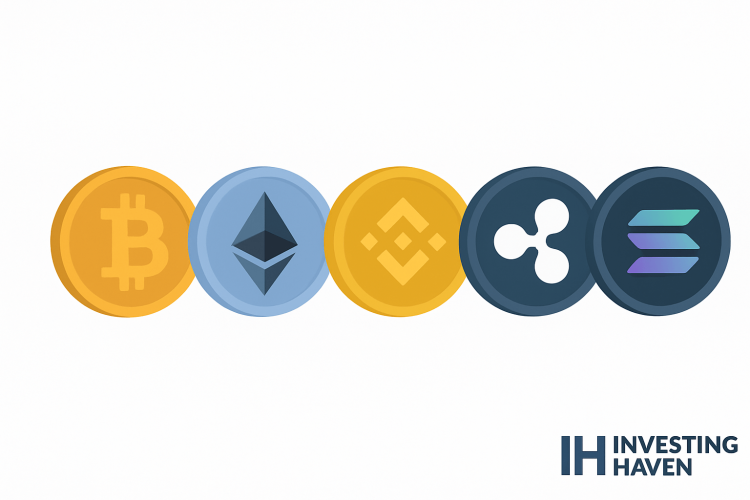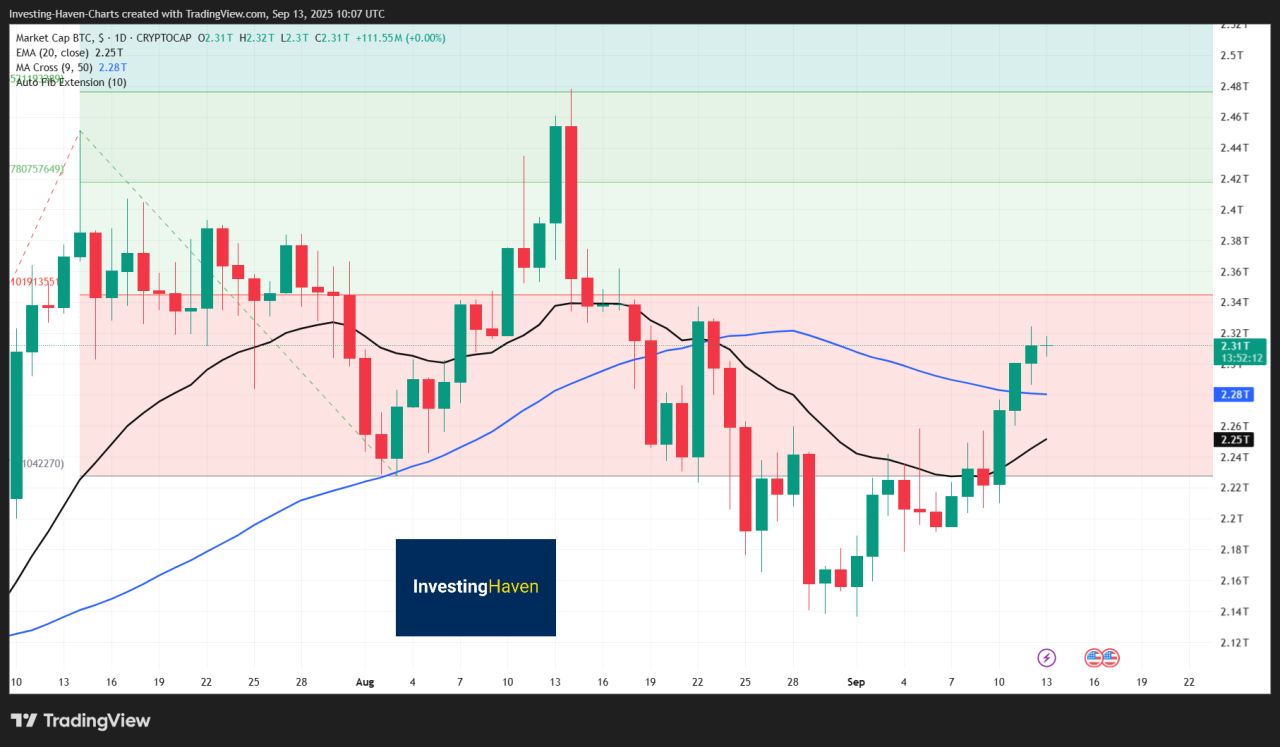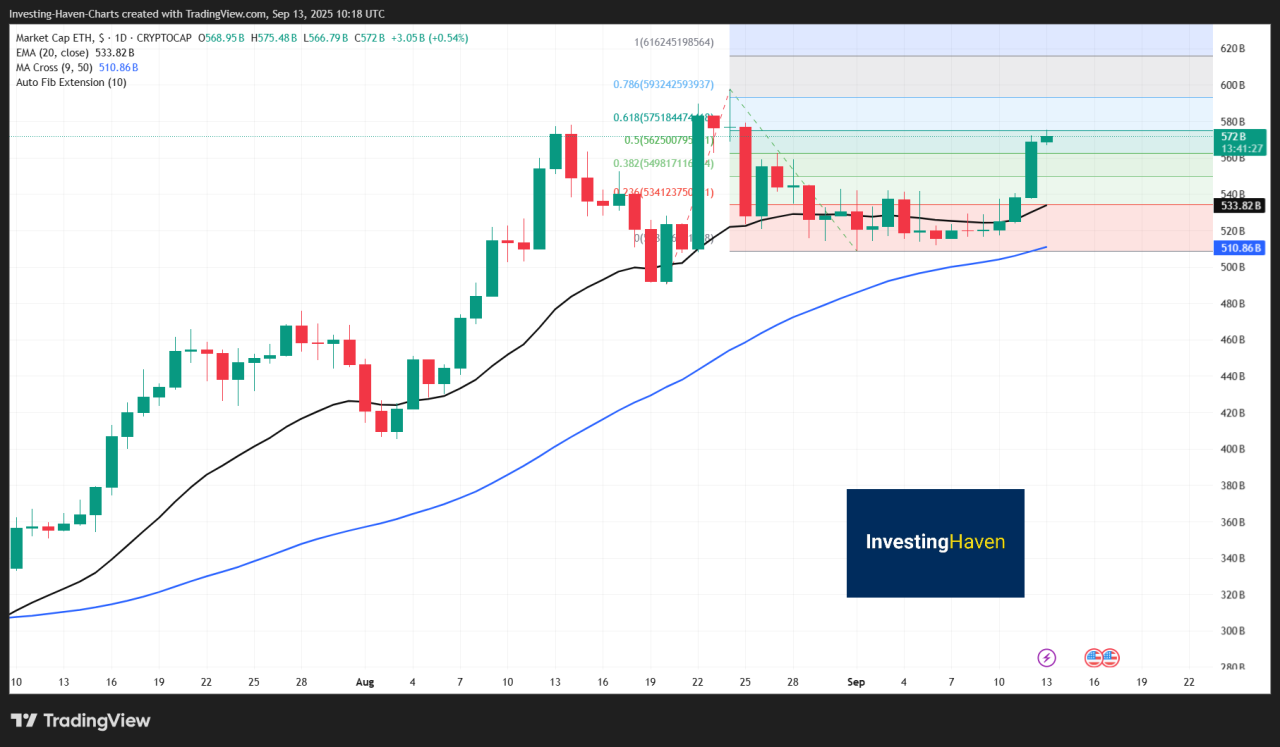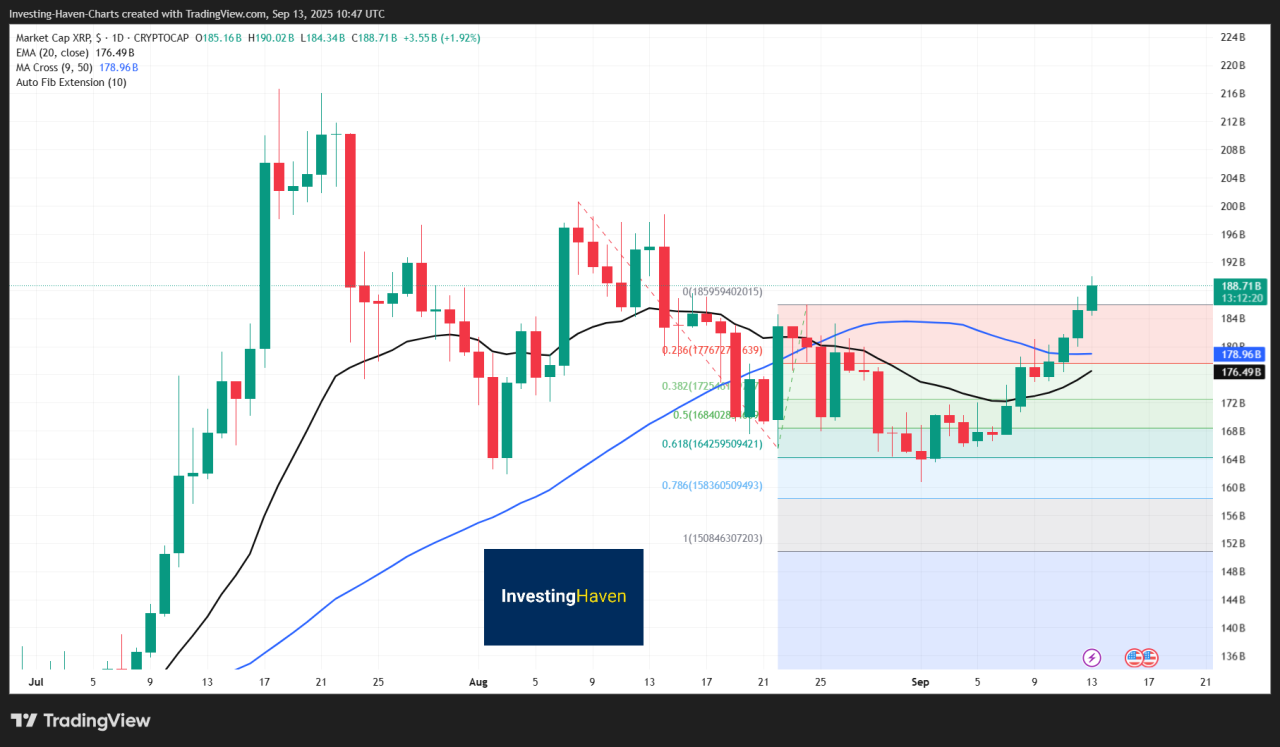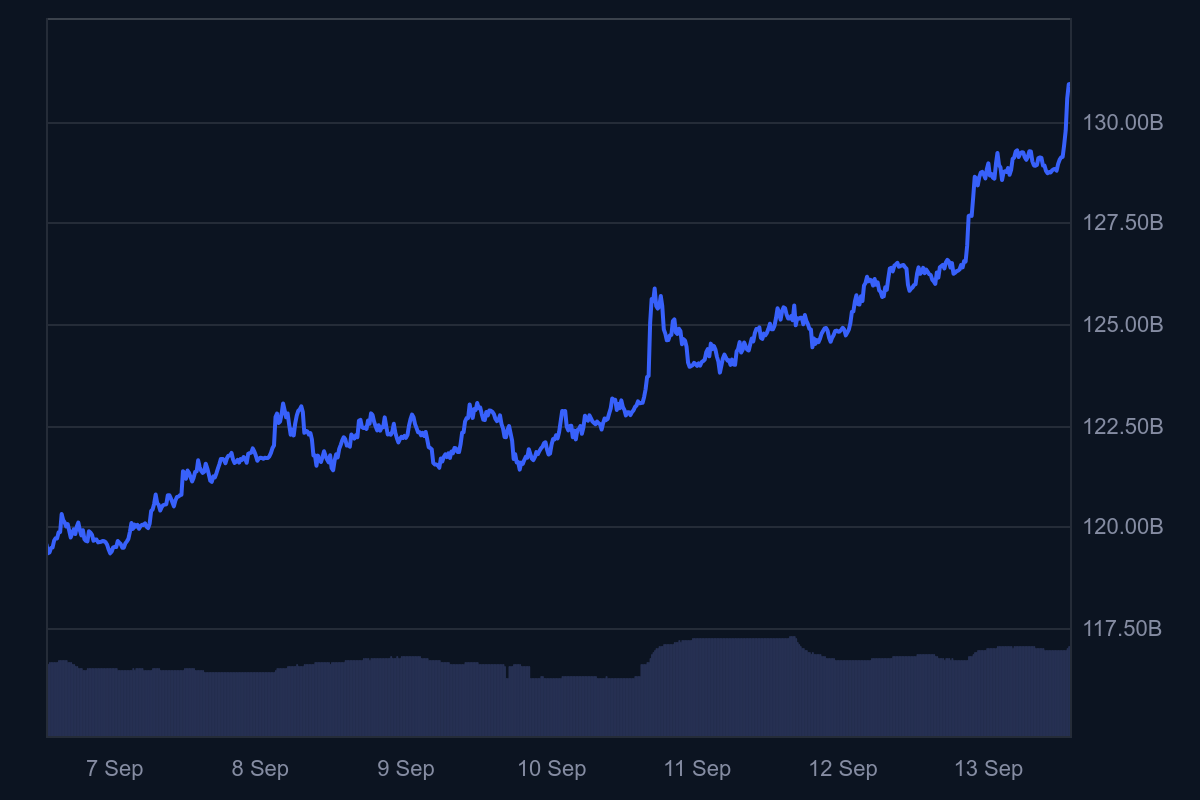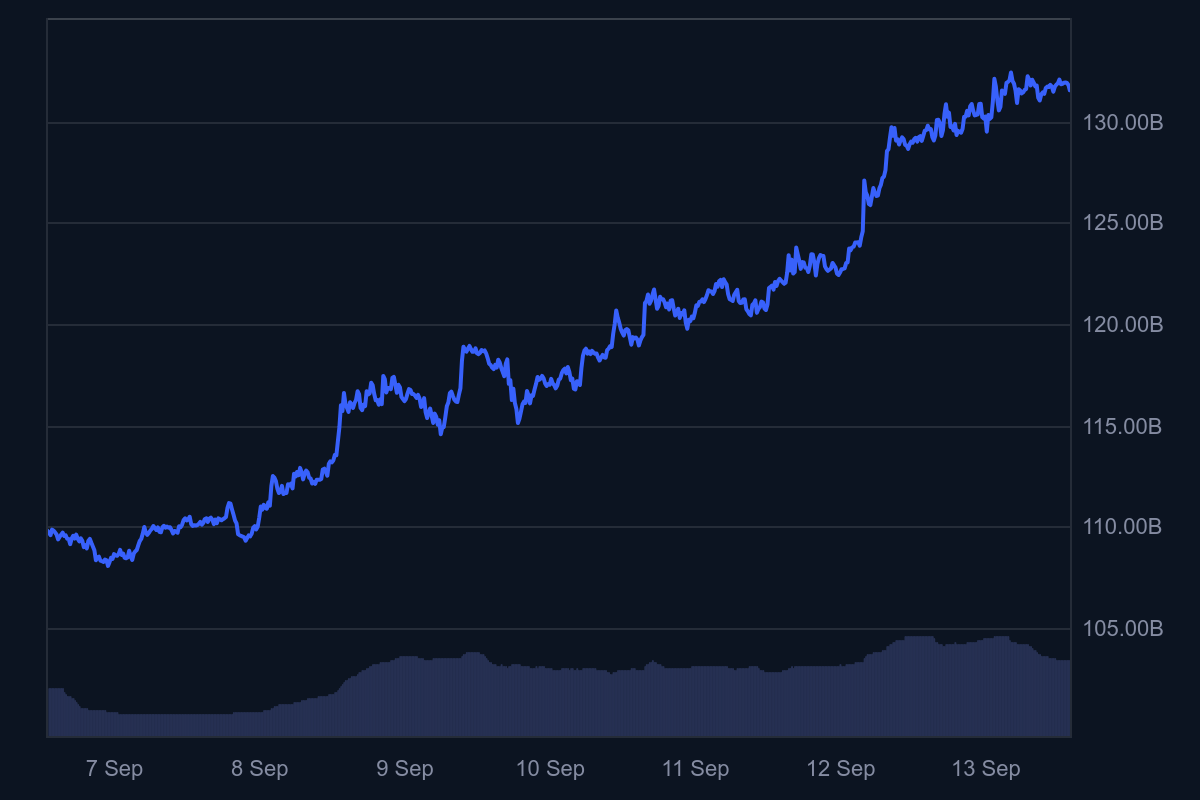Let’s explore the top large-cap cryptos over $10B market cap. Understand their fundamentals, adoption, resilience, and long-term positioning for stable crypto exposure.
Market cap measures the total value of a cryptocurrency’s circulating supply, calculated by multiplying price by circulating tokens. This metric gives a clear snapshot of relative size and market exposure.
Large cap cryptos, defined as assets with market caps above $10B and usually the best performing cryptocurrencies, sit in the top tier of that snapshot and tend to show deeper liquidity and wider exchange listings.
Evidence-based classification systems use the $10B cutoff to separate established projects from mid and small caps. For long-term oriented readers, focusing on cryptocurrencies over $10 billion market cap narrows attention to projects with measurable infrastructure, exchange support, and institutional access.
In this article, we examine cryptocurrencies over $10 billion market cap chosen for market-cap scale, multi-cycle presence, and clear utility, and it emphasizes fundamentals over short-term price moves.
The best performing cryptocurrencies we will cover include Bitcoin, Ethereum, BNB, Solana, and XRP, each discussed on fundamentals, adoption, and long-term positioning.
RELATED: 7 Best Performing Cryptocurrencies of 2025 With High Market Caps
Why Focus On $10B+ Cryptos?
Stability Compared With Small Caps
Large-cap cryptos generally trade on multiple major venues and maintain denser order books, which lowers slippage for sizable trades.
Liquidity is the practical ability to buy or sell without moving the price, and strong liquidity matters for large investors and custodians.
Popular large-cap assets rarely suffer the extreme slippage common among thinly traded tokens.
Institutional Adoption and Product Access
Assets above the $10B mark receive the most institutional attention, making them likelier candidates for custody, exchange-traded products, and prime-broker support.
For instance, U.S. spot Bitcoin ETFs have recorded days with net inflows in the hundreds of millions of dollars, a clear sign of institutional flows into large-cap crypto exposure.
Major custody providers list many large-cap tokens for institutional clients, which improves on-ramp and off-ramp reliability.
Developer Activity and Ecosystem Depth
Large-cap cryptos attract sustained developer communities, production-grade tooling, and integrations with third-party services.
That concentration creates network effects, where more developers and users draw still more integrations.
In fact, projects above the $10B threshold typically host broad ecosystems and established use cases.
Survivorship And Risk Concentration
Crypto markets experience high attrition among small projects. CoinGecko research documents that over 50% of tokens listed on GeckoTerminal stopped trading, with large waves of failures recorded in recent years.
Academic work on survivorship and delisting bias also confirms that raw performance samples skew upward if failed projects are excluded. Choosing cryptocurrencies over $10 billion market cap reduces exposure to the very high failure rate among newer, low-cap tokens.
Bottom Line
The $10B threshold does not remove volatility or regulatory risk, but it identifies assets with deeper markets, clearer institutional pathways, and stronger ecosystem support. So, if you’re an investor who prioritizes long-term, fundamentals-based portfolio, large-cap cryptos offer a more stable starting point than smaller, less liquid alternatives.
The 5 Best-Performing Cryptos Over $10B
1. Bitcoin (BTC)
Bitcoin functions as a digital store of value and a permissionless settlement layer. It leads the market in liquidity and exchange coverage. As of September 13, 2025, Bitcoin’s market capitalization was about $2.31 trillion, making it the #1 crypto asset by market cap and of the best performing cryptocurrencies.
Adoption and Utility
- Reserve Asset for Crypto Portfolios – Bitcoin is used by funds and large custodians for capital exposure and treasury allocation.
- Exchange And Custody Support – BTC is listed across spot exchanges, derivatives venues, and institutional custody platforms.
- Settlement Use – Bitcoin is used for large value transfers between institutional counterparties and miners.
U.S. spot Bitcoin ETFs have shown large daily net inflows on active days, for example daily totals above $500M reported during recent inflow runs.
BTC Market Position
- Rank: #1 by market capitalization.
- Approx Market Cap: $2.31T as of September 13, 2025.)
Why Bitcoin Is Resilient
- Network Effect – Bitcoin is the largest address base and developer tool ecosystem for settlement primitives.
- Institutional Product Coverage – Bitcoin has broad ETF and custody availability reduces operational friction for big investors.
- Scarcity Mechanics – Bitcoin’s fixed supply schedule and capped supply create a clearly defined issuance path.
FORECAST: Bitcoin Price Prediction 2025-2030
2. Ethereum (ETH)
Ethereum has always been among the top cryptocurrencies in 2025. It provides the dominant programmable ledger for smart contracts, decentralized finance, and digital collectibles.
ETH’s protocol hosts the largest developer community for application-layer innovation. As of September 13, 2025, Ethereum’s market capitalization was about $571 billion, ranking it second by market cap and among the top cryptocurrencies over $10 billion market cap.
ETH Adoption and Utility
- DeFi And Liquidity – Ethereum accounts for a large share of DeFi total value locked on chain, with on-chain TVL measured in the tens of billions.
- Staking And Security – roughly 35.8 million ETH were staked, representing about 29% of supply and supporting consensus security.
- Layer 2 And Scalability – rollups and sidechains extend Ethereum’s capacity and reduce end-user fees, increasing practical utility.
Ethereums Market Position
- Rank: #2 by market capitalization.
- Approx Market Cap: $571B as of September 13, 2025.
Why ETH Is Resilient
- Large Developer Ecosystem – ongoing protocol upgrades and rich tooling support application growth.
- Economic Activity – substantial DeFi TVL and staking create recurring on-chain demand for ETH.
- Institutional Access – multiple spot ETH ETFs and custody solutions increase institutional participation and liquidity.
FORECAST: Ethereum Price Prediction 2025-2030
3. XRP (Ripple)
XRP functions as a bridge asset for cross-border liquidity and settlement, with fast finality and low fees. As of September 13, 2025, XRP traded around $3.16 and had an approximate market cap of $188 billion and a circulating supply near 59.61 billion, placing it among the best performing cryptocurrencies.
XRP Adoption and Utility
- On-Demand Liquidity (ODL) – uses XRP to settle cross-border flows without pre-funding nostro accounts, lowering working capital needs for customers.
- RippleNet Reach – Ripple publicly documents a global customer network that includes banks, payment providers, and fintechs, with more than 300 institutions connected to RippleNet.
- XRPL EVM Mainnet – launched June 30, 2025, adds Ethereum-compatible smart contracts to the XRPL ecosystem, enabling ERC-20 dApps to operate on XRPL sidechains.
- Liquidity And Trading Volumes, XRP shows multi-billion-dollar daily volume on major exchanges, which supports larger trade sizes and institutional flows.
XRP’s Market Position
XRP ranks among the top cryptocurrencies in 2025 and sits within the top five to top seven assets depending on the feed. The asset remains one of the most liquid non-stablecoin cryptos.
Why XRP Is Resilient
- Regulatory Clarity – the long-running SEC enforcement action concluded in 2025 with the parties dismissing appeals and the court record clarified which institutional sales qualify as securities, reducing a major legal bottleneck.
- Expanded Technical Utility – the XRPL EVM sidechain opens new on-chain use cases, including DeFi and tokenization, which can increase recurring on-chain demand for XRP.
- Institutional Pathways – Ripple’s product set, custody partners, and growing RippleNet customer base make it easier for banks and payment providers to trial and deploy XRP-based solutions.
FORECAST: XRP Price Prediction 2025-2030
4. Binance Coin (BNB)
BNB serves as the native token for Binance Exchange and the BNB Chain. It reduces trading fees on Binance and pays gas on BNB Chain. CoinMarketCap lists BNB with a market capitalization of about $130 billion and a circulating supply near 140 million BNB, as of September 13, 2025.
BNB Adoption and Utility
- Exchange Utility – used to pay fees, participate in token launches, and access VIP services on Binance.
- On-Chain Gas – BNB fuels transactions and smart contracts on BNB Chain, which hosts many DeFi and NFT applications.
- Supply Management – Binance operates an automatic burn mechanism that aims to reduce total supply toward 100,000,000 BNB. The burn schedule adjusts by network activity each quarter.
BNB’s Market Position
- Rank: Top 10 by market capitalization, often ranked around #6.
- Ecosystem Size: Binance supports hundreds of tokens, millions of users, and very high daily volume, which creates persistent utility demand for BNB.
Why Is BNB Resilient
- Integrated Use Cases – the token ties directly to the world’s largest exchange, creating steady transactional demand.
- Transparent Supply Policy – the auto-burn gives a predictable path for supply reduction.
- Ecosystem Effects – many BNB Chain dApps and services keep utility on-chain for transactions and fees.
FORECAST: Binance Coin Price Prediction 2025-2030
5. Solana (SOL)
Solana focuses on high throughput and low transaction costs for decentralized applications. The chain attracts trading, gaming, and DeFi activity that requires fast confirmations. Solana has a market capitalization at about $131.4 billion and a circulating supply of around 542 million SOL, as of September 13, 2025.
SOL Adoption and Utility
- DeFi Activity – Solana’s DeFi total value locked recently reached an all-time high above $12 billion, according to DeFiLlama. That figure signals large on-chain capital deployment.
- High Throughput Use Cases – the network supports NFT marketplaces, trading venues, and game economies where speed and low fees matter.
- Developer Momentum – on-chain activity metrics show millions of daily transactions and high DEX volumes relative to other chains.
SOL’s Market Position
- Rank: Top 5 by market capitalization, often trading around the fifth-largest crypto.
- Ecosystem Growth: Rising TVL and DEX volume reflect increasing capital and trading depth on Solana.
Why Is Solana Resilient
- Performance Advantage – Solana’s architecture enables low fees and fast finality for high-frequency applications.
- Capital Inflows to DeFi – record TVL shows real capital allocators using Solana protocols.
- Risk Profile – the network faces security and centralization critiques, and academic work has documented rug pull patterns that investors should monitor. This risk does not negate adoption but it frames operational caution.
FORECAST: Solana Price Prediction 2025-2030
Best Performing Cryptocurrencies: Comparison Snapshot
| Coin | Approx Market Cap | Launch Year | Key Use Case | Long-Term Adoption Trend |
| Bitcoin (BTC) | ~$2.31T. | 2009 | Store of value, settlement | Institutional product growth and deep liquidity. |
| Ethereum (ETH) | ~$571B. | 2015 | Smart contracts, DeFi, NFTs | L2 scaling and developer activity expand utility. |
| Binance Coin (BNB) | ~$130B. | 2017 | Exchange utility, BNB Chain gas | Exchange integration and tokenomics sustain on-chain use. |
| Solana (SOL) | ~$131B. | 2020 | High-throughput dApps, NFTs, gaming | Throughput and developer growth attract high-frequency apps. |
| XRP (XRP) | ~$188B. | 2012 | Cross-border liquidity, settlement | Payments adoption and EVM sidechains broaden use cases. |
Key Trends Supporting Large-Cap Cryptos
Large-cap cryptocurrencies benefit from a set of measurable, structural trends that increase real-world utility and institutional access. These trends do not remove risk. They change the odds for long-term relevance and capital allocation.
Institutional Adoption and ETF Flows
Spot exchange-traded products for Bitcoin and Ethereum show substantial daily net inflows, reflecting active institutional allocation. On September 12, 2025, U.S. spot Bitcoin ETFs added about $552.8M in net inflows, while spot Ether ETFs added roughly $405.6M. These flows increase available liquidity and expand custody and prime-broker support for large-cap assets.
Scaling And Practical Capacity
Layer 2 rollups now secure material economic value, moving high-frequency activity off base chains and lowering user costs. Arbitrum alone lists about $20.6B in value secured, while Base lists roughly $16.1B, showing that rollups already host tens of billions in capital. These figures reflect growing real transaction volume on scaling layers.
Regulatory Outcomes And Market Access
Regulatory developments in 2025 reduced long-running legal uncertainty for major platforms. The SEC filed to dismiss its enforcement action against Coinbase and later dismissed a suit against Binance. Separately, the SEC and Ripple agreed to dismiss appeals, clarifying XRP’s secondary market treatment. Clearer enforcement outcomes improve institutional willingness to hold large-cap tokens.
Developer Activity And Network Effects
Open-source developer metrics show sustained engagement on major chains, with tens of thousands of new contributors joining in recent years.
Solana and Ethereum remain among the top attractors for new developers, which supports ongoing product launches and integrations. Higher developer activity translates into more production-grade tooling and more use cases for large-cap protocols.
Conclusion
Large-cap cryptocurrencies combine deep liquidity, broad market access, and tangible on-chain ecosystems.
Measured flows into spot Bitcoin and Ether ETFs show active institutional participation, while Layer 2 rollups and high-throughput chains host tens of billions in secured value. Developer activity and clarified regulatory outcomes create clearer pathways for adoption.
These structural advantages do not remove core risks. Price volatility, shifting regulation, and protocol-level security issues can materially affect any crypto asset, including the largest ones.
You should, therefore, treat large caps as infrastructure-grade exposures that warrant ongoing monitoring of liquidity, regulatory developments, and technical risk.
Join eToro today and receive $10 in free crypto on your first deposit. Trade crypto, stocks, and ETFs with powerful tools and social investing features like CopyTrader™
Crypto investments are risky and may not suit retail investors; you could lose your entire investment. Understand the risks here
When To Buy These Crypto Assets?
To get key insights on when to buy or sell these popular crypto assets along with insights into more opportunities, you should consider joining the original blockchain-investing research service — live since 2017.
InvestingHaven alerts come from a proprietary 15‑indicator methodology built over 15+ years of market experience.
Get insights from the service that identified major turning points through crypto winters and bull runs alike
Act now and see why thousands trust us to deliver signals before markets move.
This is how we are guiding our premium members (log in required):
- Is A Trendless Crypto Market Good or Bad? The Current and Emerging Winners Look Awesome. (Sept 7th)
- BTC Testing Long Term Trendline. Here Is Short and Long Term Guidance. (Aug 26th)
- Crypto – To Break Out Or Not To Break Out? (Aug 23rd)
- What Happened This Week? Leading Indicator Analysis and 7 Token Charts. (Aug 16th)
- Crypto Shows More Resilience Than Expected. A Bullish Impulse May Be Underway. (Aug 9th)
- Prepare To Buy The Dip In Crypto (Aug 2nd)
- Alt Season 2025 – Progress Update (July 26th)

